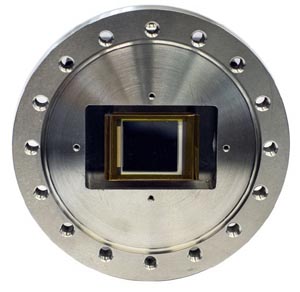greateyes introduces its next generation
portfolio of scientific, cooled cameras for imaging and
spectroscopy.
Cooled, scientific cameras with 2k x 2k pixels for UV, VUV, EUV and X-Ray imaging
and spectroscopy are now availableCooled, scientific cameras with 2k x 2k pixels for UV, VUV, EUV and X-Ray imaging
and spectroscopy are now available.
A modular camera concept
allows to operate more than 30 different scientific
CCD sensors within a single hardware platform. With a width of only 45mm, they are the most
compact detectors in the deep cooled scientific camera segment. At readout speeds of 500kHz,
they achieve a total read-noise performance of minimum 2.4 electrons per pixel.
The user can select among different models
which have an excellent spectral sensitivity in the
ranges of soft X-ray, XUV, VUV, UV, VIS and NIR up to 1100nm. Vacuum flanges, various optical
windows,greateyes introduces its next generation portfolio of scientific, cooled cameras for imaging and
spectroscopy.
|
.png)
|
The large format detectors employ e2V CCD sensor
having an image size of 27.6mm x
27.6mm, the pixel size is 13μm. The portfolio comprises several front- and back-illuminated
sensors with different spectral sensitivities. The cameras are typically offered with Conflat
flanges like CF DN100 or CF DN160.
A temporary glass window on the CCD chip protects the
image plane from being contaminated before installation take place. (As shown in the images
on the right).
The detector incorporates a three stage Peltier element reaching a cooling
temperature down to – 60OC maximum. Specific flange designs with additional vacuum ports
for connection to UHV/HV pumps are available on request.
|

|
Improved camera cooling subsystem
Cooling is necessary to reduce the thermal noise of the CCD sensor which otherwise becomes
the dominant noise source during longer exposure times.
For this purpose the sensor is
integrated together with the Peltier element in a patented hermetically sealed chamber with a
single optical window. The excess heat is removed by forced air cooling.
Besides the
improvement of the thermal design, the camera head is now equipped with an additional
water cooling adapter. In this way heat can be removed more efficiently to reach deeper
temperatures.
Sensors can be cooled down to – 45°C with forced air and to – 60°C with water cooling. or -65°C and -80°C, respectively.
|
300.jpg)
|
Readout noise performance of the greateyes cameras
Readout noise is an important performance parameter of a scientific camera. It depends on
the CCD sensor employed and on the readout electronics of the camera including the analog
digital converter.
We measured the readout noise of the greateyes cameras by taking 30 dark frame images at a
sensor temperature of -40OC. The exposure time was set to 1ms and the pixel readout
frequency was set to 500kHz.
For all pixels of the detector the single pixel noise has been
determined by calculating the standard deviation of the pixel signal across the 30
measurements. The camera gain is nearly 1 count/electron for the model under test (GE 2048
512 BI UV1). |

Single pixel noise across 30 dark image frames
The orange lines indicate the
confidence levels for 1 s, corresponding to 2.4 counts or 2.4e-. |